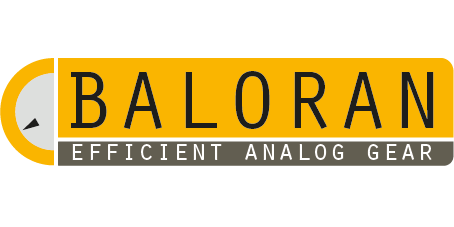News archive 2019
![]()
October 28, 2019
![]()
Important upgrade of the Genelec high-end
reference monitoring in the studio:
Genelec - 9301A Multichannel AES/EBU Interface

AVID - HD I/O Digital - 16 x 16 channel
192 kHz 24-bit Digital Interface

The Genelec 9301A Multichannel AES / EBU Interface was specially designed for Genelec 7300 Series Smart subwoofers. This 19" rack module doesn't look particularly spectacular, but it opens up access to the digital world for the Genelec reference monitoring in the studio.
Until now, all Genelec SAM™ monitors in the studio were fed with analogue signals, while all these monitors can also be used with digital AES/EBU signals. With the Genelec 9301A Multichannel AES / EBU Interface it becomes possible to actually do this including the two Genelec - 7360A SAM™ Studio Subwoofers in the studio. The Genelec 9301A Multichannel AES/EBU Interface extracts the low frequencies from all incoming AES/EBU signals that go to the Genelec SAM™ monitors, merges these low frequencies and forwards them through the AES/EBU to the two Genelec - 7360A SAM™ Studio Subwoofers. It does not do more, but it is essential for correct digital control of the subwoofers
The main advantages of sending digital AES/EBU signals to the Genelec SAM™ monitors instead of analogue signals are:
- the full dynamic range of the 24-bit digital audio signal can be utilized, allowing the Genelec SAM™ monitors to handle the incoming audio signal 'more accurately', in contrast to an analogue signal that is less accurate
- with analogueue signal, the audio signal is first digitized inside the Genelec SAM™ monitor itself, then this digital signal is filtered according to the settings of the Genelec AutoCal data that is controlled via the Genelec GLM software, and then this signal is made analogue again to go to the internal amplifiers that control the actual speakers inside the Genelec SAM™ monitor. So 1 analogue to digital conversion is lost by immediately offering the audio signal digitally
- but there is also 1 less digital to analogueue conversion because all audio in Pro Tools | HDX is digital anyway and for feeding analogue signals to the Genelec SAM™ monitors this digital signal must first be made analogue. This is done with the DA converters present, eg the AVID HD I/O from Pro Tools | HDX can be heard, or via the Apogee ROSETTA 200 or the GraceDesign m906 monitor controller. Each of these DA converters give their analogue character (coloring) to the analogue audio signal that they produce and this is therefore completely eliminated when sending digital AES/EBU signals directly from Pro Tools | HDX to the Genelec SAM™ monitors
With digital AES-EBU signals, therefore, there is no longer any external factor present that can negatively influence the audio signal and thus you obtain a truly professional reference sound that comes from the Genelec SAM™ monitors. With analogueue control this is by definition not the case, although for the sake of honesty I have to add that the analogueue control of the Genelec SAM™ monitors is also very very good and the differences in sound quality between feeding analogue or digital signals are much smaller than one might expect at first sight (hearing?). As mentioned above, this mainly concerns the differences between DA converters that give their own character (coloring) to the analogue audio signal.
This ability to feed the Genelec SAM™ monitors with AES/EBU signals may seem like a major upgrade, but with my previous Genelec monitoring (5 x 8130 + 7060 subwoofer) I could also switch between feeding them analogue or digital via AES / EBU in 5.1 surround (the Genelec 8130 monitors were the first Genelec monitors that could be fed both analogue and digital). Actually during these days I had a special custom-build audio switcher built for this. With this audio switcher I could choose with 1 push of a button to send analogue or AES / EBU signals to the 5 x 8130.
However, the only problem then was that the Genelec 7060 subwoofer had no AES/EBU input and could therefore not be fed digitally. So I had to be a bit 'creative' at the time and, when monitoring digitally, still feed the subwoofer with an analogue audio signal. It all sounded pretty good at the time, but it was obviously technically not entirely correct.
But now it's just like back then, with the custom-build audio switcher I can switch back between analogue or digital AES/EBU signals in 5.1 surround or 2.1 stereo, but this time entirely with digital AES/EBU signals up to 129 kHz and without having to be to be creative with analogue signals for the two Genelec - 7360A SAM ™ Studio Subwoofers!
But ... before everything worked, I was unexpectedly confronted with a problem. Genelec now only uses the standard 'single wire' AES/EBU protocol (which was previously limited to 96 kHz and now also works up to 192 kHz) while my old Digidesign 192D interfaces for Pro Tools | HDX still work with the old 'dual wire' AES / EBU protocol for 192 khz . So the Genelec - 9301A Multichannel AES/EBU Interface could suddenly not be connected to my old Digidesign 192D interfaces...
So in order to be able to use the studio entirely via AES/EBU at 192 kHz, I also had to invest in an AVID - HD I/O Digital - 16 x 16 channel 192 kHz 24-bit Digital Interface that does have the standard single wire 'AES / EBU protocol up to 192 kHz, long live the progress in digital technology! :-)
![]()
September 28, 2019
![]()
New in my synthesizer collection:
waldorf - STVC
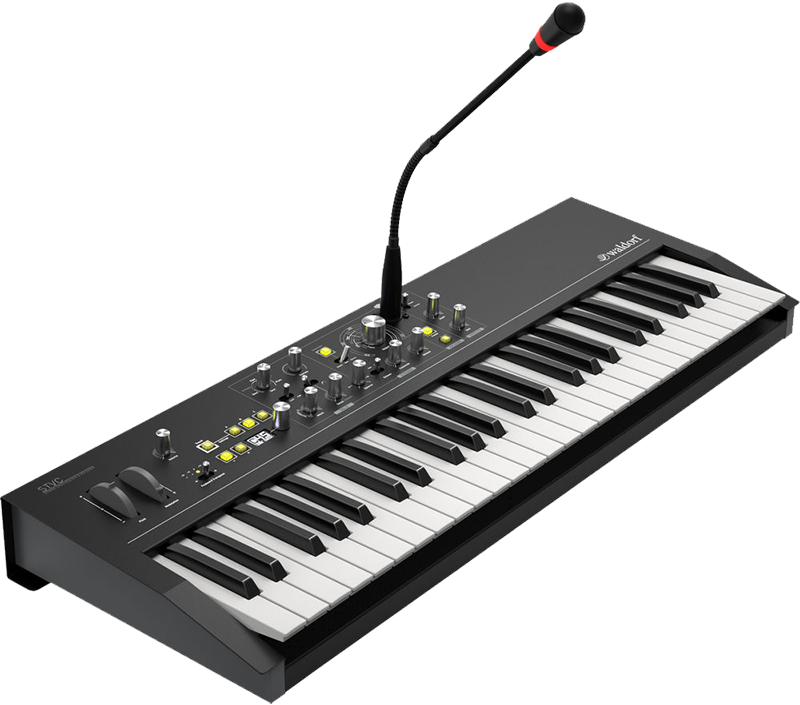
The first thing you can say about this new synthesizer is 'better late than never', because it was already announced at the Winter NAMM Show in Orange County, California from ... 2018!
The waldorf STVC was actually announced together with the waldorf QUANTUM and that had to be waited for a long time, the release was always delayed (I received mine on October 13, 2018, as can be read on my 2018 news page). And with the waldorf STVC it went from bad to worse, because waldorf took a full year more to get this machine on the market.
The name waldorf 'STVC' comes from 'STringer VoCoder', so this machine is comparable in many ways to the Behringer VC340 that I bought on 28 June 2019 (see below). That is, the STVC is also a stringer with a vocoder, but with 2 important differences.
The first major difference is that the Behringer VC340 is a copy of the Roland VP-330 Vocoder Plus mk2 from 1980 and therefore completely analogue, while the waldorf STVC is completely digital. It is derived from the small waldorf streichfett string synthesizer module from 2015 (which, by the way, is still available).
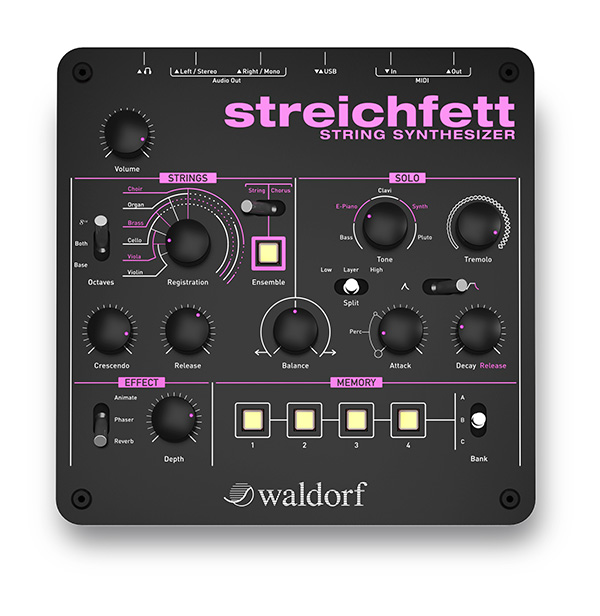
The STVC is a copy of the streichfett that has been improved in many respects, including a very solid keyboard + metal housing. But here too waldorf copied itself because the waldorf STVC ...
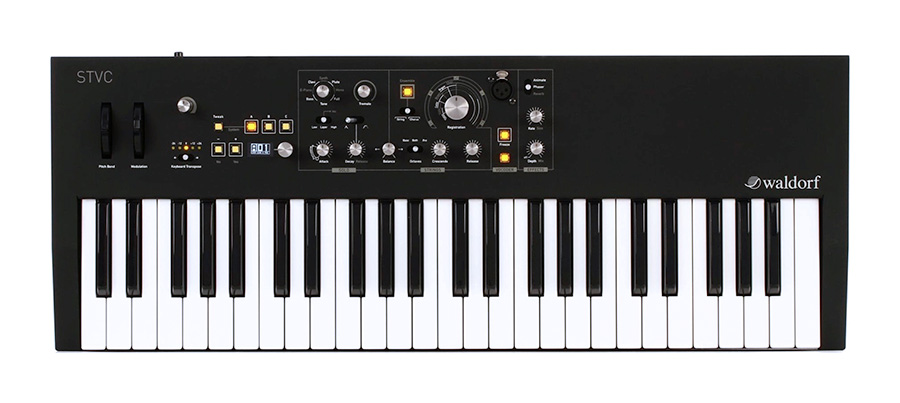
... in terms of housing is identical to the housing of waldorf blofeld Synthesizer (the 2009 version with keyboard):
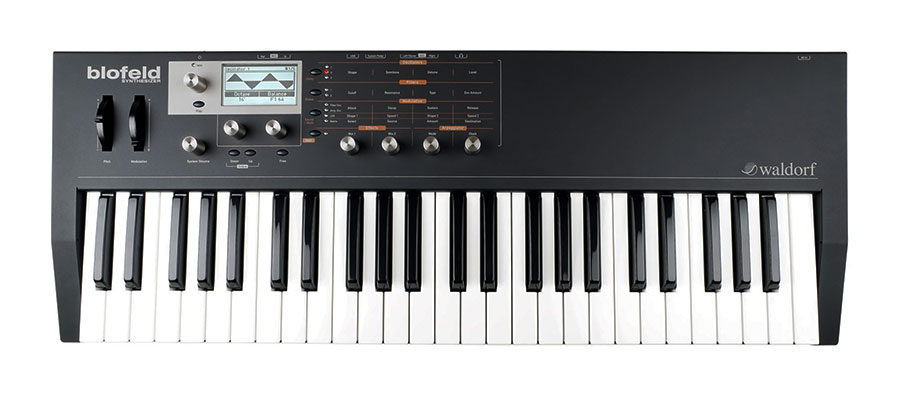
The second major difference with the VC340 Behringer that has an analogue 10-band vocoder (and with the waldorf streichfett) is of course the addition of a digital vocoder. This vocoder consists of 250 (!) Bands with full polyphonic carrier (!), the possibility to change the formant (male / female), Freeze mode, etc ...
Because the vocoder is completely linked to the internal streichfett string synthesizer, the vocoder also benefits from the newly added possibilities of the streichfett string synthesizer, these are some differences with the streichfett module:
- full polyphonic (just like the module) but with the possibility to morph between the different stringer sounds instead of switching (so you can let the timbre slide from one to the other, from strings to choirs to organ sounds)
- the solo section is now 16-voice polyphonic instead of monophonic
- 3 banks with 42 sounds instead of 3 banks with 4 sounds
- the built-in effects Animate (LFO modulation), Ensemble / Chorus, Phaser and Reverb have more setting options and can be used simultaneously
- a tiny OLED screen, but very handy
- and of course the keyboard with 49 keys with aftertouch and pitch bend and modulation wheel
And it is also stated that the wavetable engine responsible for all sounds has been adapted and modernized, making the waldorf STVC fuller and warmer than its old brother the streichfett string synthesizer module
Actually this machine is a complete surprise for me because just like many others, I thought that Waldorf had stopped the release because almost two years have passed since the first announcement. The cancellation would probably have been due to the great success of the VC340 Behringer, as a result of which waldorf saw its market share for the STVC more or less evaporate.
But yesterday I started reading messages that there were people who owned a waldorf STVC (there were 3 different machines 'out in the wild' seen on different photos). In the meantime, a very small number appears to have been delivered (only in Europe) and to my great surprise one was still available at Bax Music. I have not hesitated for a moment to order it, because there is a good chance that, just as with the QUANTUM waldorf, they will be available sparingly and it may take months before they become available in sufficient numbers.
So until 3 months ago I didn't have any stringer in my collection and now I suddenly have 2! The Behringer VC340 if I want the real old, analogueue sound and the waldorf STVC for everything else with virtually unlimited and especially new sound possibilities due to the possibility to morph between the different stringer sounds instead of switching.
![]()
September 14, 2019
![]()
New in my synthesizer collection:

BLACK CORPORATION
DECKARD'S DREAM EXPANDER

I already mentioned the DECKARD'S DREAM EXPANDER in my post of 13 March 2019 about the DECKARD'S DREAM synthesizer (see bottom of this page) and it is finally available! The day it was for sale in Europe, I immediately bought it and in the meantime it was delivered.
Initially there were 2 different versions:
- the DECKARD'S DREAM EXPANDER with an envelope controllable Ring Modulator, Chorus, Tremolo, Delay and Reverb effects:

- the DECKARD'S DREAM EXPANDER as a kit with 16 CV inputs with an envelope controllable Ring Modulator, Chorus and Tremolo, but without Delay and Reverb:

But in the meantime it appears that the version as a kit with 16 CV inputs has remained a prototype and only the DECKARD'S DREAM EXPANDER with an envelope controllable Ring Modulator, Chorus, Tremolo, Delay and Reverb effects was taken into production (but available as a kit and already built entirely in the factory in Japan).
You can say that the DECKARD'S DREAM EXPANDER is not really a synthesizer, although the fully analogue envelope controllable Ring Modulator contains a sine wave oscillator that serves to modulate the incoming sound of the DECKARD'S DREAM synthesizer. The result is the typical metallic sounds for which the YAMAHA CS-80 is so famous. And it is just that Ring Modulator that was missing in the DECKARD'S DREAM synthesizer (together with the Sustain function that is also present on the DECKARD'S DREAM EXPANDER). So you could say that DECKARD'S DREAM EXPANDER makes the DECKARD'S DREAM synthesizer even more of a YAMAHA CS-80 and therefore more or less 'complete'.
And I have to say, the envelope controllable Ring Modulatorin the DECKARD'S DREAM EXPANDER is wonderful and fun to experiment with. None of my other synthesizers has a Ring Modulator and it opens up a whole new pallet of sounds. Vangelis used this effect a lot, the first time was on the album 'Spiral' from 1977. On this album he tried out the possibilities of the YAMAHA CS-80 for the first time, but actually he used the envelope controllable Ring Modulator on this album rather little and especially very subtle. But if you really want to know what you can do with an envelope controllable Ring Modulator then you should definitely listen to the very experimental album 'Beaubourg' by Vangelis from 1978, the extreme envelope controllable Ring Modulator effects literally blows you around, wiep wiieeeup wiiiieeeeeeeeeuuuup woieeeeeuuuoeoeoeoewoew!
But the DECKARD'S DREAM EXPANDER goes a little further than just an envelope controllable Ring Modulator, because alsoe extra Chorus, Tremolo, Delay and Reverb effects have been added. These are not entirely analogueous, they are DSP-based, with each effect having its own DSP chip. But all dry / wet and feedback paths are analogueous, which in turn makes these effects more vintage than is the case with most contemporary digital effects processors.
The DECKARD'S DREAM EXPANDER can also be used as a separate effects processor without the DECKARD'S DREAM synthesizer because the module has standard audio inputs and outputs. So in principle I can use it with every synthesizer that I have, although I don't intend to do so because for me both together form one indivisible instrument.
The DECKARD'S DREAM synthesizer and the DECKARD'S DREAM EXPANDER are integrated into the studio in this way:
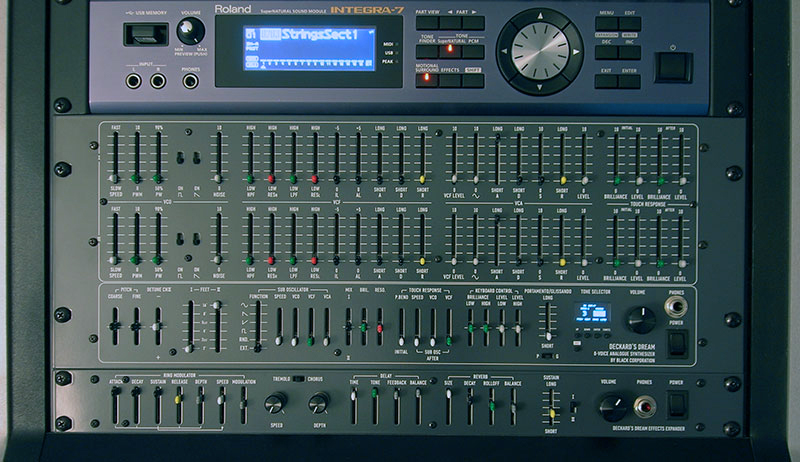
![]()
June 28, 2019
![]()
New in my synthesizer collection:
Behringer - Vocoder VC340
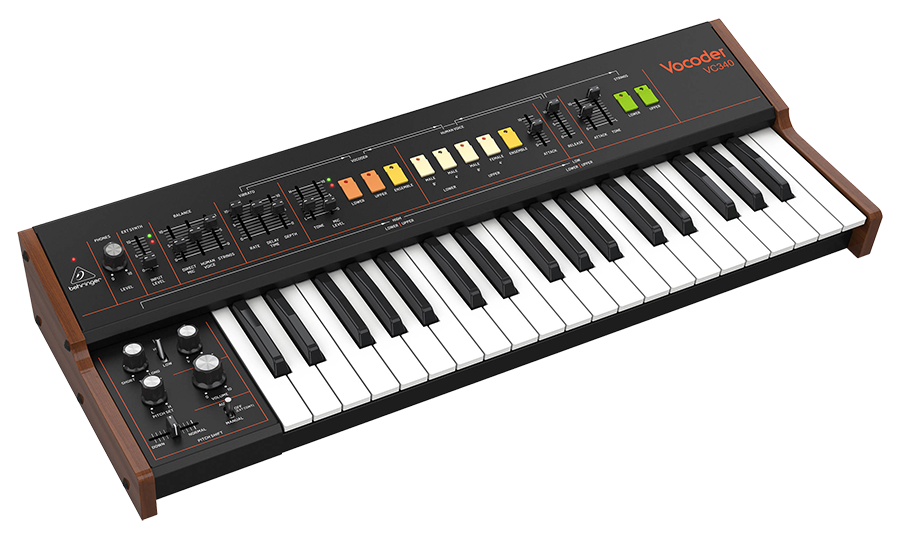
People who are a little familiar with synthesizers will see immediately this Behringer Vocoder VC340 appears to be a copy of the legendary Roland VP-330 Vocoder Plus. And that's correct!
This is a Roland VP-330 Vocoder Plus mk1 from 1979:

This is a Roland VP-330 Vocoder Plus mk2 from 1980:
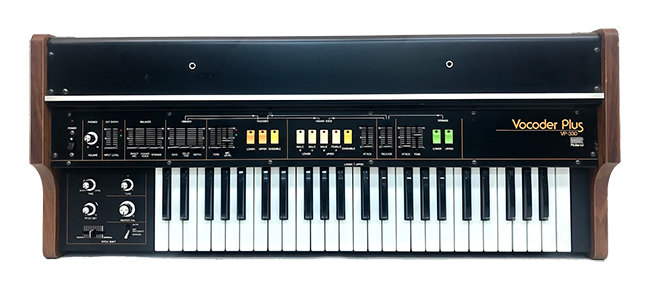
And this is the Behringer Vocoder VC340:
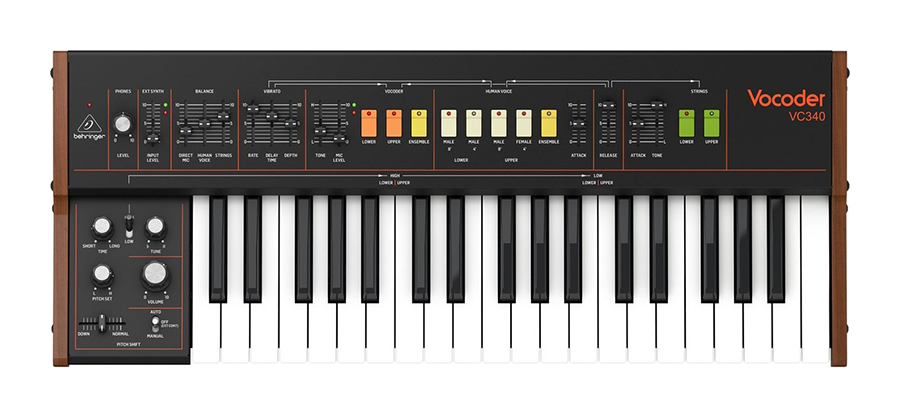
It is clear that Behringer has virtually taken over the design of the Roland VP-330 Vocoder Plus mk2, but the Behringer Vocoder VC340 is somewhat smaller with a keyboard of only 3 octaves. Perhaps also the electronic design is based on the Roland VP-330 Vocoder Plus mk2 but then built with tiny SMT (surface-mount technology) parts that did not yet exist in the Roland VP-330 Vocoder Plus period.
However, there is 1 big difference between the two machines: the Roland VP-330 Vocoder Plus was paraphonic (2-voice) and the Behringer Vocoder VC340 is completely polyphonic, so you can play all keys simultaneously. This is, of course, a huge improvement on the original Roland VP-330 Vocoder Plus.
Just like the original Roland VP-330 Vocoder Plus, the Behringer Vocoder VC340 consists of 2 separate machines: an analogue 10-band vocoder and an analogue 'stringer' that uses a 'divide-down oscillator'. As a result, it actually belongs to the electronic organs and is therefore not a real synthesizer that uses one or more VCO, VCF, VCA, ENV and LFO for sound generation. There is also an ensemble effect (chorus) for which analogueue BBD (Bucket Brigade Device) chips are used.
The legendary vocoder needs little explanation, this is considered the best analogue vocoder ever designed and generates the typical robot voices from the 80s. The 'stringer' imitates strings and polyphonic choirs with a dozen presets that you can combine with each other and adjust to your own taste.

So actually this is a very simple device, but what it does does it very well!
Everything sounds old, melancholic and hopelessly dated, but that is precisely the intention. In terms of sound, the original Roland VP-330 Vocoder Plus and the Behringer Vocoder VC340 are almost identical, Behringer has really succeeded in reviving the old legend. And this also for a fraction of the price of an original used Roland VP-330 Vocoder Plus. The Behringer Vocoder VC340 has been on the market for a few weeks now and the user reviews are very positive and I can only confirm this: it sounds great and authentic.
By the way, Behringer is busy reviving quite a few classical analogue synthesizers, for example, they have already released the Behringer MODEL D (copy of a moog MODEL D) and the Behringer MS-101 (copy of a Roland SH-101) . But there are also a lot of other synthesizers on the program.
But still I am not too happy to buy them all, because my collection of synthesizers now includes just about all types of synthesizers that exist and certainly on the analogueue level my exclusive BALORAN THE RIVER has closed a lot of holes. The only thing that was missing in my collection was an old analogue vocoder and 'stringer' that gives you the jitters and that is there now, the Behringer Vocoder VC340, brand new, with a 3-year manufacturer's warranty.
With just a few buttons flying back to the '80s, it's nothing more, but I love it!
![]()
May 05, 2019
![]()
New in my synthesizer collection:
BALORAN - THE RIVER
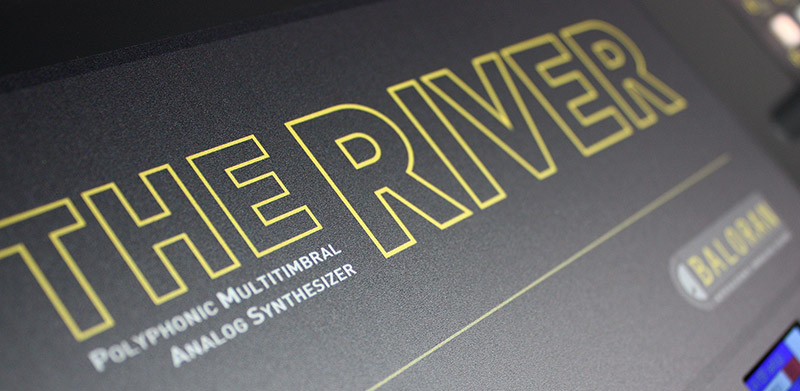
I already announced it in my last post in 2018, when I wrote that another synthesizer was coming... and a very exclusive 'boutique' analogue synthesizer... and that it was built by hand in France at that time... and I would be 1 of the 20 lucky ones to receive one... and that there are only 42 of them around the world...
And on April 9th, the day before my 52nd birthday, the BALORAN THE RIVER was finally delivered after six months of waiting, what a wonderful birthday present!
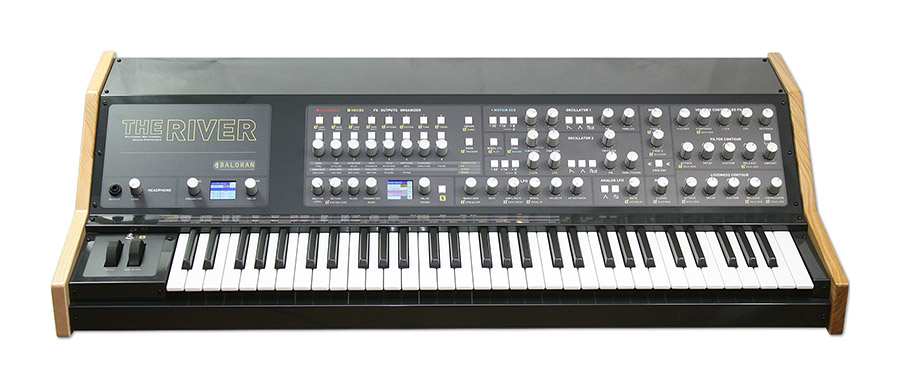
It turns out that actually there are 43 pieces and that I have received no. 41. And in the meantime it is already known that BALORAN is going to build 50 more and that they are all reserved in advance. This of course only shows that this synthesizer is very popular and also very special.
The BALORAN THE RIVER was designed and is also built entirely by hand by Laurent Lecatelier from the one-man company BALORAN in the north of France (Beuvry). He builds this synthesizer in his garden shed and is based on the moog THE SOURCE, a legendary monophonic synthesizer designed by Dr. Bob Moog in 1981:
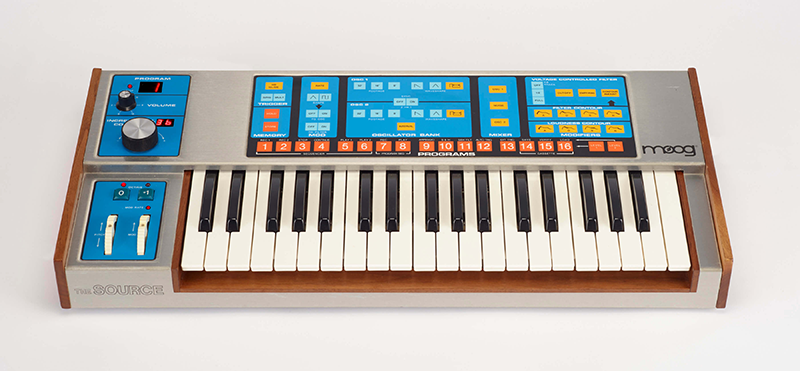
This was a 100% analogue monophonic synthesizer with membrane push buttons and only one rotary knob (data wheel) to set values. However, this was not a great success because you were very limited with that one rotary knob to edit sounds because you could only check one parameter at a time. This while all other synthesizers at the time had many buttons that you could operate with multiple hands at the same time.
But the moog THE SOURCE was the first moog synthesizer with a memory to store sounds in (16 sounds + the possibility to save those sounds on a cassette tape and load them back) and that gave the moog THE SOURCE a certain popularity, especially for live use.
In terms of sound, the moog THE SOURCE with its 2 oscillators does have the one and only authentic, fat, warm vintage moog sound that the moog synthesizers are so famous for and of course it also has the legendary 24 dB moog Ladder filter.
Laurent Lecatelier first and foremost recreated the voice board of the moog THE SOURCE as well as possible, so the BALORAN THE RIVER is indeed a moog THE SOURCE, but that is just the beginning ... Because in a BALORAN THE RIVER there are not 1 but 8 identical voice boards present, so a BALORAN THE RIVER is actually an 8-voice polyphonic moog THE RIVER. And it goes even further than that because it is also 8-voice multi-timbral, so each voice can be a totally different sound. So it's really 8 separate analogue moog THE SOURCE synthesizers in a box and it is exactly that what makes the BALORAN THE RIVER so special and unique.
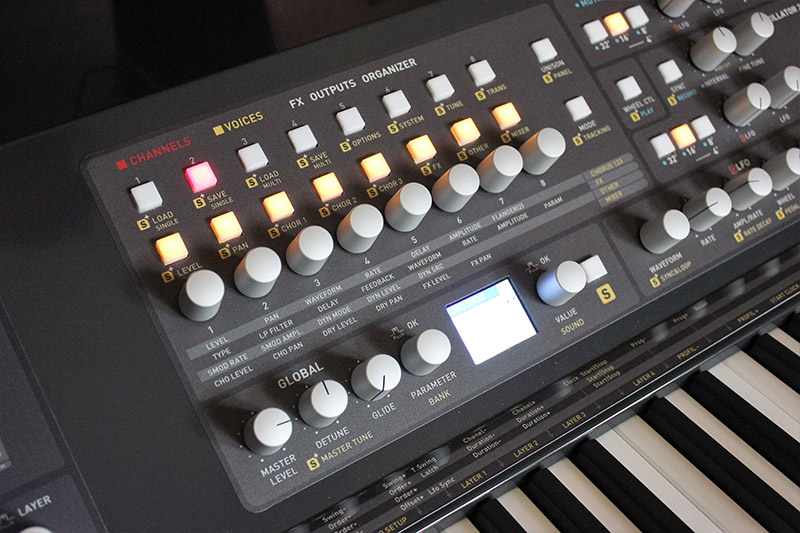
By the way, there are actually only 2 polyphonic moog synthesizers: the 6-part memorymoog from 1982:
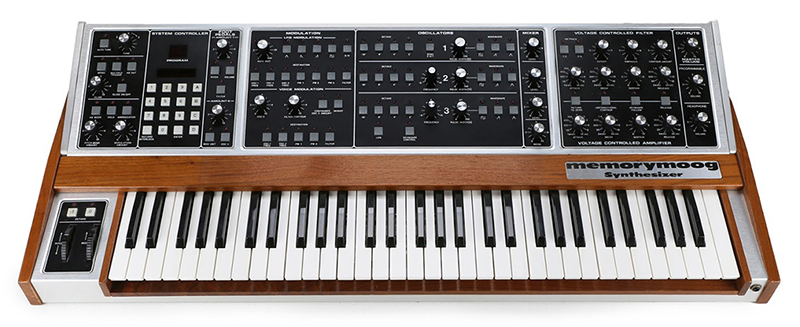
And the 8 or 16-voice moog One released in 2018:

(for the sake of completeness: there is also the moog Polymoog from 1975 with unlimited polyphony and the 3-voice moog OPUS 3 from 1980, but both machines use a 'divide-down oscillator', are therefore actually electronic organs and are therefore no real synthesizers that use one or more VCO, VCF, VCA, ENV and LFO for generating sound)
But even though the moog One resembles an old moog memory mover in terms of design, the moog One is primarily a modern contemporary synthesizer and it no longer has that typical vintage moog sound from the 70s and 80s (by the way, it was'nt designed by Dr. Bob Moog either).
So you could actually call the BALORAN THE RIVER the second vintage polyphonic moog synthesizer that Dr. Bob Moog never built in the 80s but was built by Laurent Lecatelier in 2018.
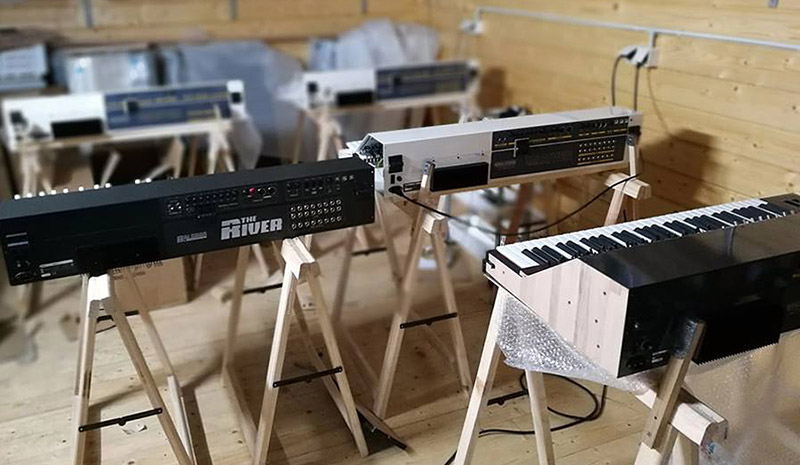
© Baloran
The BALORAN THE RIVER is built entirely by hand by Laurent Lecatelier, giving you some options in finishing. You can choose from different connection options on the back, whether you want a black or white version and which type of wood is used for the wooden side panels. I have chosen a black version with light wooden side panels, the photo below comes from the Baloran catalog and these are the 'natural' side panels that are mounted on my BALORAN THE RIVER (both pictures show my unique wooden side panels):
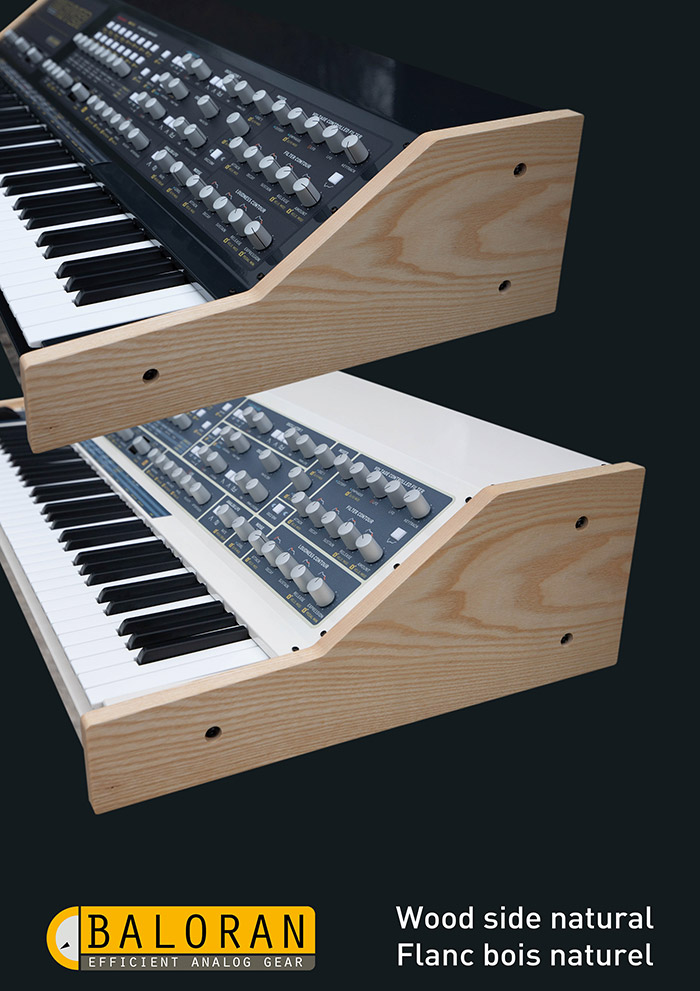
And this is a photo of my BALORAN THE RIVER at its final place in the studio under my moog 'Aluminum' MINIMOGUE VOYAGER (of which only 100 exist). As you can see, the wooden side panels fit well with the wooden finish of the wall coverings of the studio:

The BALORAN THE RIVER is therefore first and foremost an 8-voice analogue synthesizer with a vintage sound and it has some special features:
- a built-in analogue Triple Chorus / Flanger Triple Chorus / Flanger with BBD (Bucket Brigade Device) chips, so 3 separate analogueue chorus circuits that can be used in different combinations with or next to each other. There is also a digital Reverb / Delay present, but it remains completely beside the 100% analogueue signal path of the synthesizer so the warm analogue sound always remains unaffected.
- 8 analogue LFOs, so each voice (!) has its own LFO, this is very exceptional and contributes greatly to the lively and natural sound of the BALORAN THE RIVER (there is also a separate and very extensive digital LFO that all 8 votes works simultaneously)
- volume, panning and transposing per voice!
- ADSR with modular Attack and Release
- 16 CV and 8 Gates connections to integrate the machine in an analogue modular synthesizer setup
But from a technical point of view, the BALORAN THE RIVER certainly did not get stuck in the 80s, because there is also present among other things:
- 4 layers with splits + 4 sequencers + 4 arpeggiators
- full MIDI implementation with CC and NRPN (both via MIDI and via USB)
- and last but not least: the BALORAN THE RIVER is 100% MPE compatible, so I can play it perfectly with my ROLI Seaboard RISE 49, just like the DECKARD'S DREAM, beautiful !!
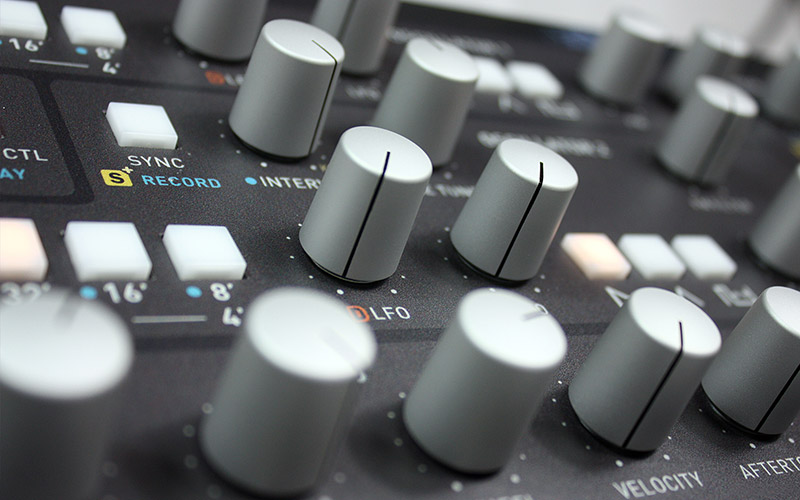
I have the BALORAN THE RIVER in the studio for a few weeks now and I can only say that this machine exceeds my wildest expectations. He really has that old warm vintage analogue tone color and sometimes I really feel that I could warm my hands to the warm sound coming from the speakers, very bizarre.
I also have the strong idea that I won't need any other vintage analogue synthesizer in the future. Even my dream to own an original Roland JUPITER-8 has disappeared because the BALORAN THE RIVER sounds so much better and goes so much further. And together with the DECKARD'S DREAM, I think this is an unbeatable duo that even a moog One cannot match.
And of course it is also nice that the BALORAN THE RIVER is a very exclusive 'boutique' analogue synthesizer of which there are currently only 43 pieces. Perhaps this is only temporary, maybe Laurent Lecatelier will build or have them built in large numbers within a few years, but this machine is and will always be the BALORAN THE RIVER with serial number 41, built entirely by hand in a garden shed in the north of France (Beuvry) by a man whose sole purpose was to build "his" analogue dream synthesizer with the highest possible quality of electronic components.
And he succeeded particularly well in that, bravo!
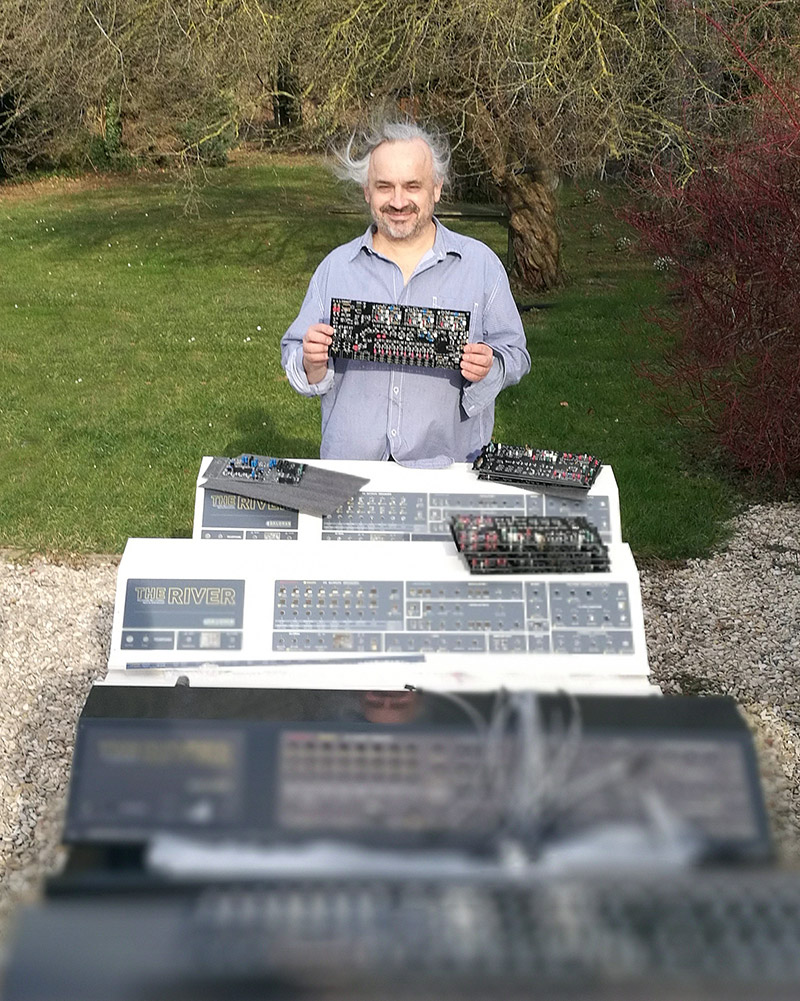
Laurent Lecatelier - © Baloran
FYI, actually, since the new moog One entered the market, I haven't heard a single online demo of the moog One that gave me goosebumps. With BALORAN THE RIVER this is just the opposite, here I almost always get goosebumps when I listen to a demo.
As a matter of fact, it was actually at www.gearslutz.com in the forum about Electronic Music Instruments and Electronic Music Production in the first thread about the new moog One that I read for the first time about the existence of the BALORAN THE RIVER.
Then I listened to some of the BALORAN THE RIVER YouTube videos on the site of Laurent Lecatelier on www.baloran.com and that experience was so overwhelming with so much goosebumps (certainly the MPE demo with a ROLI Seaboard RISE 49) that I decided to make an online reservation of a BALORAN THE RIVER that same saturday evening. And a day later, all 20 machines from the 2nd batch were sold out (and now I know that I managed to get hold of the one before last).
That's how fast it can go sometimes, I can only be very happy that I followed my heart and I didn't mind at all that I had to wait 6 months for delivery.
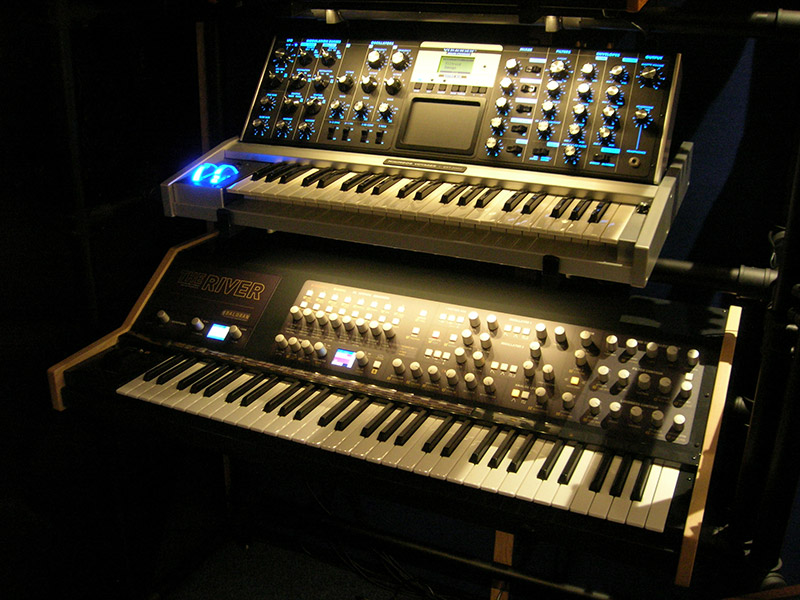
Oh yes, where does the name THE RIVER come from?
The moog THE SOURCE is a source ... and the THE RIVER is a river...
A river comes from a source ... and in this case that river has not one source but 8 sources! Voila!
![]()
March 13, 2019
![]()
New in my synthesizer collection:

BLACK CORPORATION - DECKARD'S DREAM
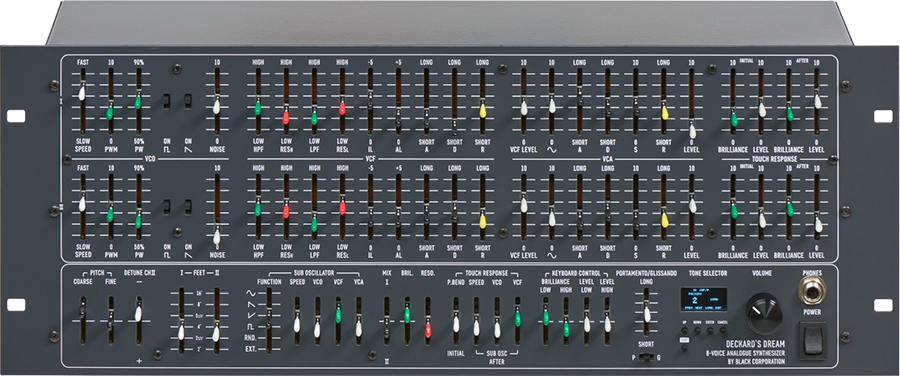
Since my childhood I have been a big fan of the Greek composer Evanghelos Odysseas Papathanassiou, also known as Vangelis.
Vangelis is of course best known for the use of synthesizers in the creation of his music and his records were no more or no less than a revelation for me (and perhaps for everyone at the time). And so Vangelis was also indirectly responsible for purchasing my first synthesizer in the early 1980s (it was a KORG MS-20), because I also wanted to be able to make such strange electronic sounds.
Since his record 'Spiral', Vangelis made frequent use of the legendary YAMAHA CS-80 synthesizer that was made in Japan from 1976 to 1980:
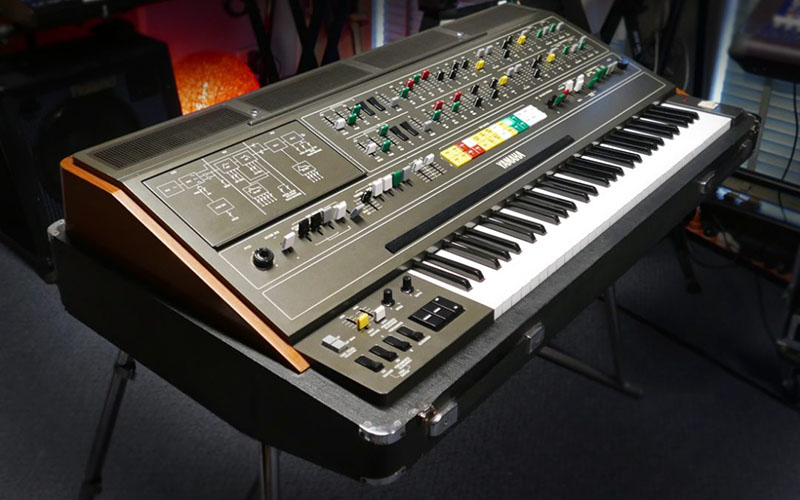
Vangelis considers this heavy-duty machine that weighs more than 100 kg as "the most important synthesizer in its career". Today he still owns more than 5 of them, some of which are aways in a repair shop, of course after more than 42 years on the market this is not entirely illogical. And this repairing is work for specialists because the electronics used at the time are of course not what they are today, this is a detailed photo of the inside of a CS-80 (the 16 voice cards):
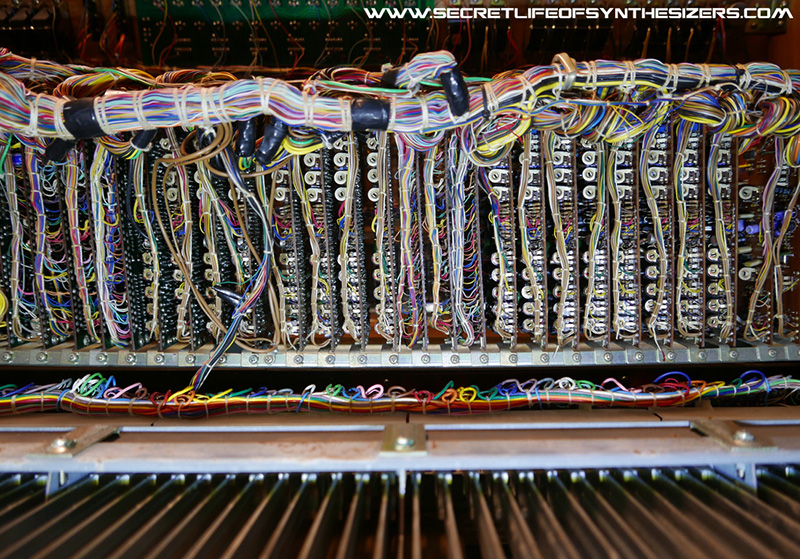
In that period synthesizers only had presets (the CS-80 had 26 under the colored push buttons) and there was no possibility to store self-programmed sounds because the digital technology to perform that was still in its infancy (the Sequential Circuits Prophet 5 that came on the market in 1978 was the first synthesizer with digitally stored presets). But still the Yamaha CS-80 had the ability to store 6 self-programmed sounds. Two sounds were the current position of the large faders on the front panel, but at the top right of a folding panel there were 4 rows of miniature faders where you could make 4 more sounds, as can be seen below:
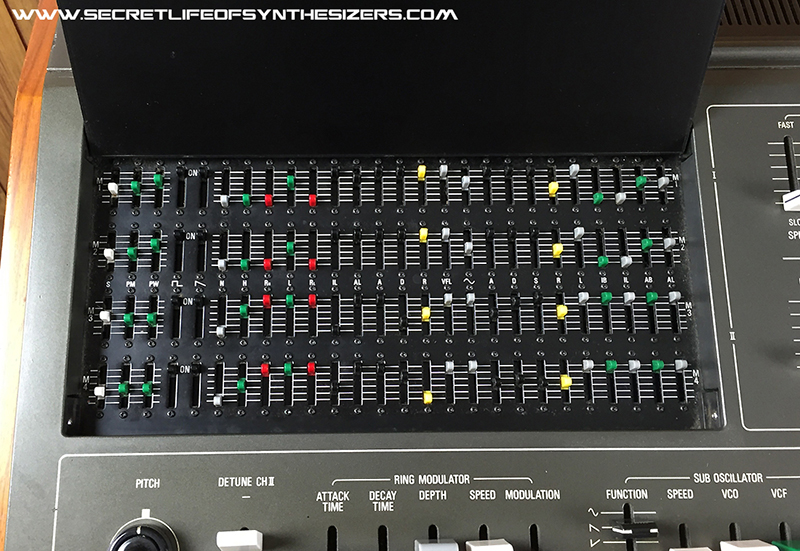
If you compare these miniature faders with the miniature faders on the front panel of the DECKARD'S DREAM, you'll immediately see the similarities:
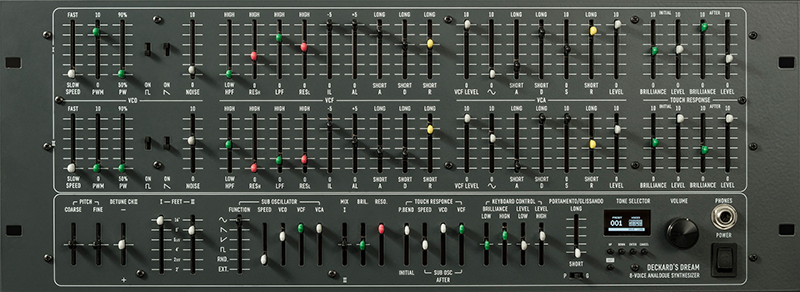
Vangelis has used the YAMAHA CS-80 very prominently, a very nice example of this is his music for the legendary science fiction film Blade Runner by Ridley Scott from 1982. In the film, the main character is called Rick Deckard, and BLACK CORPORATION got its inspiration from this fact to name their version of the YAMAHA SC-80 DECKARD'S DREAM.
The DECKARD'S DREAM is a so-called 'boutique' analogue synthesizer that was designed by Roman Filippov, one of the most renowned designers of Eurorack modules in the world. He started his career with Sputnik Modular in Moscow but later moved to Tokyo and started there with BLACK CORPORATION.
His goal was to bring the YAMAHA CS-80 back to life by means of 'reverse engineering'. But since the technology is now much more advanced then 42 years ago, the DECKARD'S DREAM has much more options than the YAMAHA CS-80 now and therefore it stands entirely on its own as a contemporary analogue synthesizer, although the basic architecture is the same as the CS-80 (eg also 8-voiced with 2 layers and with similar filters).
The DECKARD'S DREAM is therefore not identical to the YAMAHA CS-80, but still comes very close in terms of possibilities. Of course, the legendary CS-80 keyboard with polyphonic aftertouch and the ribbon controller to make pitch bends is missing. But this was conveniently solved by making the DECKARD'S DREAM fully compatible with the new MIDI MPE standard (MIDI Polyphonic Expression). In other words: I can perfectly play the DECKARD'S DREAM with my fantastic ROLI Seaboard RISE 49!
The only thing really missing is the CS-80's Ring Modulator, but this is solved by the DECKARD'S DREAM EXPANDER with an envelope controllable Ring Modulator, Chorus, Tremolo, Delay and Reverb effects:

However, it will only be available in Japan from May 2019 + there will also be a version available as a kit with 16 CV inputs, but without Delay and Reverb:

Which of the 2 different DECKARD'S DREAM EXPANDER's I will purchase has not yet been decided, perhaps I will first wait for the online reviews once these devices are available.
For your information: the DECKARD'S DREAM itself is also available as a kit. As a matter of fact: it was initially only available as a kit, the pre-build version came later on the market fof people like me who do not feel suited to build such a machine all by themselves.
Of course, the most important aspect of the DECKARD'S DREAM remains: what does it sound like?
On the one hand you can say that this is the umpteenth analogue 8-voice synthesizer in the row that works according to the classical substractive synthesis that has been used since the 1970s. And that of course is true. But does it also sound like a real YAMAHA CS-80?
I have never had the honor to play a CS-80, so I cannot judge firsthand. But if I read the reviews online, it will still be 90 to 95% close to a CS-80, so that is certainly not bad at all. An additional point is that today no YAMAHA CS-80 sounds the same anymore because the electronics are now 42 years old and every CS-80 has aged differently. One was, for example, very regularly maintained and was installed in a recording studio, another has been traveling for 30 years and has experienced extreme live conditions. This means that a DECKARD'S DREAM may sound very similar to one CS-80 and sometimes cannot be compared to another CS-80.
But when I listen to my DECKARD'S DREAM myself, I really hear that typical, somewhat nasal tone of a YAMAHA CS-80 that I can't find in my other synthesizers, so this machine is really an asset to my collection. And when I use my ROLI Seaboard RISE 49 with all its modulation possibilities, the DECKARD'S DREAM really becomes a dream to play and it goes much further than a YAMAHA CS-80 ever could, beautiful!
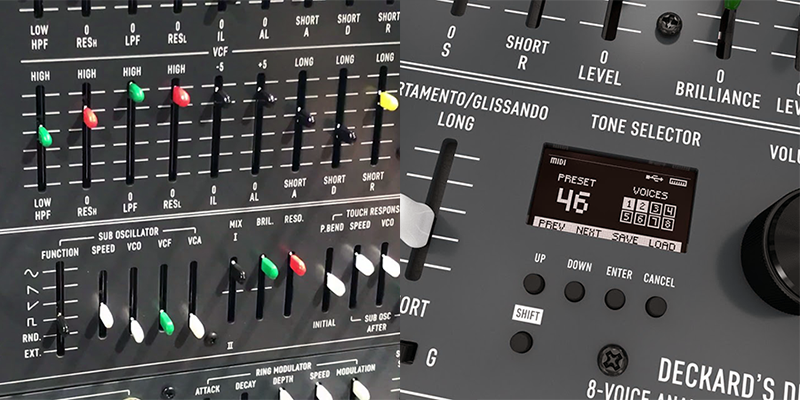
![]()

![]()
![]()
Copyright © 1995-2025 by Delta Music Belgium • Dolby Atmos Music Studio • Rummenweg 30 • 3800 Sint-Truiden • Belgium
All Rights Reserved
Privacy notification and cookie policy
All product names, logos, and brands are property of their respective owners.
All company, product and service names used on this website are for identification purposes only.
Use of these names, logos, and brands does not imply endorsement.
![]()






